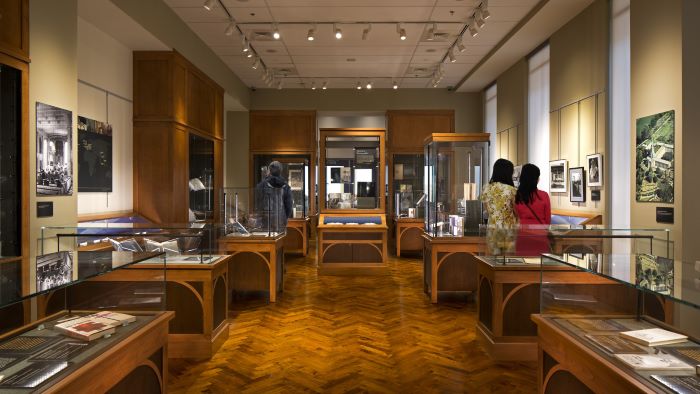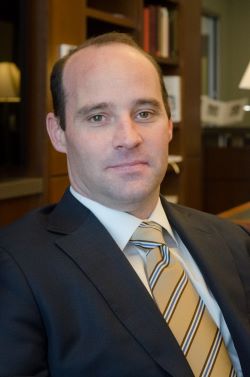
The Pitts Theological Library, which opened in 2014, includes group study rooms, an exhibit gallery (shown here), a lecture hall, and a dedicated reading room for access to the library’s special collections and archives.
Photo Credit: Collins Cooper Carusi Architects Inc.
In spring 2019, the In Trust Center sent a survey about theological libraries to 2,618 presidents and board members of theological schools in the United States and Canada. The purpose: to discover what these seminary leaders think about their own school’s library — how important it is to the mission of the school, how they think students and faculty have been using the library over the last five years, and whether they anticipate that the library budget will increase or decrease over the next few years. We did not send the survey to librarians because our goal was to report to librarians what governance leaders at their schools think about the library.
We received 186 responses — a 7.1 percent response rate. With this modest return rate, the survey results should be considered suggestive, not statistically rigorous.
More than 60 percent of respondents reported that their institution is a freestanding school with its own library. About 20 percent reported that their library is part of a larger university or college collection, and the remainder said their library is part of a consortial arrangement.
Most respondents said they believe that, during the last five years, students have been using the physical collection in the library (i.e., books, print periodicals, and special collections) less than in previous years, and that faculty have been using it “about the same.”
Not surprisingly, respondents said that, during the last five years, both students and faculty have been using electronic resources (i.e., e-books, online journals, full-text articles, and databases) “more” or “much more” than in previous years, and that they have been using reference and circulation services (i.e., the reference desk, online reference help, and interlibrary loan) at about the same rate as in previous years.
The survey also asked whether respondents anticipated that the budgets for these service areas would increase or decrease over the next five years. Most reported that the budgets for the physical collection would likely decrease or stay the same, while budgets for electronic resources would likely increase, andcbudgets for reference and circulation services would likely stay the same.
Open-ended responses
Next, the survey asked a few open-ended questions. When asked, “In what ways does the library contribute to your mission as a theological school?” the vast majority of respondents said something like “It is essential” or “It is a key partner,” whereas a smattering responded with comments such as “The library is a repository of the past,” “It’s an important gathering spot,” or even “Not much value.”
When asked, “What do you wish you could say anonymously to your librarian?” the responses varied significantly. Some lauded their librarian with comments like “Good job!” Others offered suggestions like “Collaborate more” or “Change the physical space.” Finally, a small number of respondents (about 7 percent) made truly negative comments about their libraries and librarians.
When asked what they perceive to be the biggest threat to theological libraries, respondents’ answers fell into a few familiar categories. Technology (and its effect on libraries, librarianship, and learning) was the threat most often cited. Other threats that were mentioned included: the whole context of learning is changing, the practice of religion is changing, rising costs, decreased funding, and decreased seminary enrollment.
Big-picture lessons from the survey
- Board members and presidents perceive that, over the last five years, students and faculty have been using the physical collections less and electronic resources more. Some presidents and board members worry that this shift will result in “losing our past.”
- Board members and presidents anticipate that budgets for electronic resources will increase over the next five years, while budgets for physical collections and library services will probably decrease or stay the same.
- Most board members and presidents feel strongly that the library contributes to the educational mission of the school. Others see it differently — to them, the library is more of a holding place for historical artifacts or a social gathering spot than an essential tool for scholarship and teaching.
- Even when given the chance to voice their opinions anonymously, only a few board members and presidents expressed criticism for librarians.
- Board members and presidents widely acknowledge the current threats to the library and a few say they would like to warn librarians that there will be additional challenges in the near future, including that “further cuts are coming” or that there are already plans to merge their own library with another institution’s library.
If you would like a copy of a PowerPoint presentation that includes the survey data and a sample of the responses to the open-ended questions, contact the In Trust Center at resources@intrust.org.
How are theological libraries used today?
By Karen Stiller
Speak too loudly and you can still be shushed in the Pitts Theology Library at Candler School of Theology of Emory University in Atlanta. But if you visit a public library in most cities, you may discover that shushing is no longer a given. Many libraries have been reimagined as communal gathering places where quiet reading and study are not necessarily the main activities.

Bo Adams
“On the one hand, there’s been a push to think about the library as space — the most logical being study space,” says Bo Adams, the library director at Pitts. “But we’re not a coffee shop library; it’s not loud and open with food and drink everywhere. We’re still a very quiet library. We sensed a need for that on campus.” The two big screens in the library, installed specifically for students to work together in groups, have not even been used yet. “We thought they would sit around and show their PowerPoints, but they didn’t,” says Adams.
Greg Henson, president of Sioux Falls Seminary, says he believes that these days, brick-and-mortar libraries are mostly “gathering spaces, not places you go to get information.” The library collection at Sioux Falls is integrated into the collection of the Mikkelsen Library at Augustana University, which is just across the street from the seminary. But Henson says that most Sioux Falls students access the resources they need online.
“It used to be the problem was access to resources,” says Henson. “That’s not a problem now. You can get a lot of information easily and quickly.” Now, the challenge for librarians is to help students learn to evaluate the quality and veracity of the overload of resources available to them. “We have to shift our focus to helping students develop information literacy skills.”
Jerry Reisig, director of library services at New York Theological Seminary, agrees that students need to learn how to analyze sources. “They need to know how to look at information and know if it has value.”
And yet, theological libraries, with their stacks of books and quiet study nooks, are still considered important physical spaces. “‘Are you a service or a building?’ I think we’re both,” says Hugh Rendle, director of library services at Tyndale University College & Seminary in Toronto. “The space is valued by the community. It becomes their home outside of the classroom. The service is also important. I don’t think it would be a library without the two.”
Rendle, who completed library school in 1987, reports, “I remember them telling us that our generation of librarians would see the greatest change in libraries that had ever taken place. I think that’s true.”